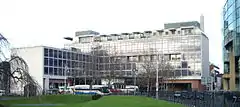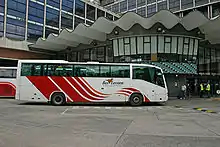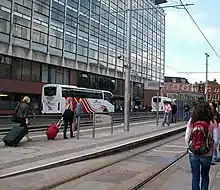Busáras
Busáras (Irish pronunciation: [ˈbˠɔsˠˌɑːɾˠəsˠ]; from bus + áras "building") is the central bus station in Dublin, Ireland for Intercity and regional bus services operated by Bus Éireann. Busáras is also a stop on the Red Line of the Luas system, in Store Street just before the terminus at Dublin Connolly railway station. Áras Mhic Dhiarmada ("Mac Diarmada House") is the official name of the building, which also includes the headquarters of the Department of Social Protection.[1] CIÉ, parent of Bus Éireann, leases the lower floors from the Department.[1] Áras Mhic Dhiarmada is named after Seán Mac Diarmada, a leader of the Easter Rising in 1916.[2]
| Busáras | |
|---|---|
 Busáras in 2008 | |

| |
| General information | |
| Architectural style | International Modern |
| Location | Store Street, Dublin 1 |
| Coordinates | 53.3499°N 6.2520°W |
| Current tenants | Bus Éireann (CIÉ), Department of Social Protection |
| Construction started | 1945 |
| Completed | 1953 |
| Renovated | 2007 |
| Cost | IEP 1,000,000 |
| Renovation cost | €1,700,000 |
| Owner | Government of Ireland |
| Design and construction | |
| Architect | Michael Scott |
| Awards and prizes | Royal Institute of the Architects of Ireland (RIAI) Triennial gold medal |
| Renovating team | |
| Renovating firm | Collen Construction |
Architecture
Busáras was designed by Michael Scott and his team of young architects and designers between 1945 and 1953. It was built against a background of public opposition which centred on the external appearance, function and excessive cost – over £1,000,000 before completion in 1953.[3] Simultaneously loathed by some of the populace and loved by architectural purists, the building was designed in an International Modern style between 1945 and 1953. A number of the original fixtures and fittings designed by Scott still exist, including terrazzo floor tiles, and large timber wall panels.

One of the first modern buildings in Dublin that attempted to integrate art and architecture, utilising elements like glass facades and a pavilionised top storey, the building won the Royal Institute of the Architects of Ireland (RIAI) Triennial Gold medal in 1955.[4] It was featured on the highest value stamp issued in the Architecture definitive postage stamp set issued in 1982 by the P&T, the forerunner of An Post.
The Eblana Theatre, originally intended as a newsreel venue, in the basement of the building was used as a theatre venue from 1959 to 1995.[5]
The building was praised for use of materials and paint effects that enhanced texture and brass, bronze, copper, mosaics, and exotic timbers often featured in Michael Scott's work.
Developments
In 2006, Bus Éireann sought planning permission for the €2 million-plus second phase of refurbishment of the building. The proposal involved repairing and cleaning the bronze glazing and brickwork at ground floor level, to be overseen by conservation architects and an expert in bronze. Proposed works on the west-facing entrance lobby included new entrances at both sides, with bronze automatic sliding doors and uplights installed to the underside of the canopy.[6]
The refurbishment work was carried out by Collen Construction over a period of seven months and had a contract value of €1.7m.[7]
Luas stop
.jpg.webp) A view down the platforms at Busáras Luas stop | ||||||||||||||
| Location | Dublin Republic of Ireland | |||||||||||||
| Owned by | Transdev | |||||||||||||
| Operated by | Luas | |||||||||||||
| Line(s) | Red | |||||||||||||
| Platforms | 2 | |||||||||||||
| Construction | ||||||||||||||
| Structure type | At-grade | |||||||||||||
| Other information | ||||||||||||||
| Fare zone | Central/Red 1 | |||||||||||||
| Key dates | ||||||||||||||
| 26 September 2004 | Station opened | |||||||||||||
| Services | ||||||||||||||
| ||||||||||||||

Busáras is an served by Dublin's Luas light rail tram system. The Luas stop is located in Store Street, and is one of only three stops on the system with an island platform. When it opened in 2004,[8] it was the penultimate stop on the Red Line for trams travelling north to Connolly. In 2009, the line was extended and Busáras became the last stop before a junction, with trams either turning left to Connolly or continuing eastwards towards The Point. Passengers at Connolly who wish to board the Luas are encouraged to make the short walk to Busáras, where trams are more frequent.[9]
References
- Lacey, Bernadette (19 December 2008). "Social Insurance Fund : financial statements 2007" (PDF). Department of Social and Family Affairs. p. 10. Retrieved 2009-06-25.
- Clerkin, Paul (2003). "Fifty years of Busáras". History Ireland. 11 (2): 38–42. ISSN 0791-8224.
- "Busaras". Irish Architecture. Archived from the original on 28 January 2011. Retrieved 4 July 2011.
- "Busaras - Triennial Gold Medal - Irish Architecture Gallery". RIAI. Retrieved 4 July 2011.
- "Grande dame of Eblana". Irish Times. 6 January 2001.
- Morgan, Edel (16 March 2006). "Exterior upgrade planned for Busaras". The Irish Times. Retrieved 2009-06-25.
- "Bus Aras Refurbishment". Collen Construction. Archived from the original on 16 June 2013. Retrieved 14 May 2013.
- https://web.archive.org/web/20080228163348/http://www.rpa.ie/luas/about_luas/background
- https://luas.ie/busaras.html
External links
| Wikimedia Commons has media related to Busáras. |
- Busáras archiseek.com
- Luas official Busaras stop site